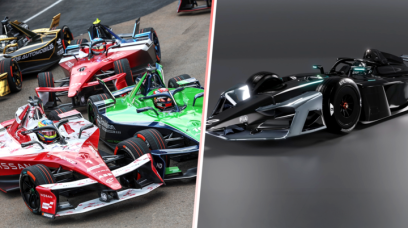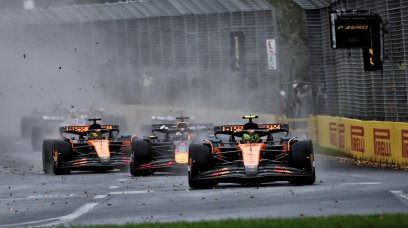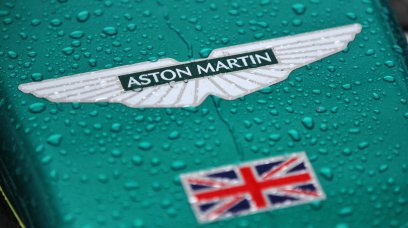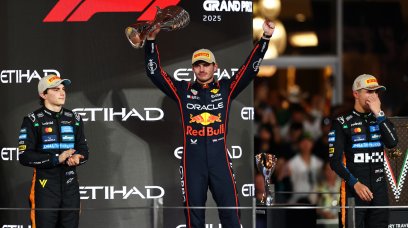Ferrar's 2024 Formula 1 challenger is officially named the SF-24 - a perfectly conventional name combining Scuderia Ferrari and the year it will race.
The team has now largely settled upon the SF-XX nomenclature after years of changing the designations from season to season in stark contrast to rival teams.
Red Bull has stuck rigidly to the RB-XX systems for its machines, with the 2021 car being the RB16B instead of RB17 after the carry-over from 2020, with the '22 car being the RB18 to carry on the sequence.
Mercedes calls its cars W-XX going back to its first season back as a works outfit in 2010, with the W standing for Wagen, the German for car.
So how can Ferrari have names such as the F2003-GA, 248 F1, 150 Italia, SF71-H and SF1000?
RacingNews365 takes a look back at Ferrari's odd naming scheme, since the 2000 season.
Viewed by others:
Between 2000 and 2008, the naming scheme was largely easy to follow with the cars following a naming scheme of F-XXXX for the year.
Michael Schumacher's title-winning cars went from F2000 to F2004, with the only exception being the F2003-GA of 2003.
The GA suffix was added as a tribute to FIAT chairman Gianni Agnelli who passed away in January 2003. Agnelli's grandson is John Elkann, the current chairman of Ferrari and also of the Stellantis automotive group with the likes of FIAT, Alfa Romeo, Chrysler, Citroen, Dodge and Maserati all members.
In 2006, Schumacher's final year, the team dubbed the car the 248 F1 to celebrate the first 2.4 litre V8 engine that the regulations now demanded, whilst the '09 machine was dubbed the F60 in honour of 60 years of the team in F1.
It in then in the 2010s that Ferrari's naming scheme began to change.
The 2010 machine was the F10, and was followed by the 150 Italia for 2011, to pay tribute to 150 years of Italian unification.
For the final year of the V8 engines in 2013, the F138 was produced before the F14-T for the first attempt at a turbo hybrid engine followed in 2014.
The next major change came in 2019 for the SF-90 for 90 years of Ferrari, with the 2020 car carrying the SF1000 name in honour of the team reaching 1,000 World Championship Grands Prix in the Tuscan GP at Mugello.
Since then, the team has settled on the SF-XX name, with the exception coming in 2022, as the F1-75 celebrated 75 years since the very first Ferrari.
Check out all the names of Ferrari F1 cars since 2000 below!
Ferrari car names in Formula 1
| Season | Car name | Meaning |
|---|---|---|
| 2024 | SF-24 | Scuderia Ferrari, 2024 |
| 2023 | SF-23 | Scuderia Ferrari, 2023 |
| 2022 | F1-75 | Formula 1, 75 years since the first Ferrari |
| 2021 | SF-21 | Scuderia Ferrari, 2021 |
| 2020 | SF1000 | Scuderia Ferrari, 1000th Formula One Grand Prix |
| 2019 | SF90 | Scuderia Ferrari, 90th anniversary of the F1 team |
| 2018 | SF71-H | Scuderia Ferrari, 71 years since the first Ferrari, Hybrid |
| 2017 | SF70-H | Scuderia Ferrari, 70 years since first Ferrari, Hybrid |
| 2016 | SF16-H | Scuderia Ferrari, 2016, Hybrid |
| 2015 | SF15-T | Scuderia Ferrari, 2015, Turbo |
| 2014 | F14-T | Ferrari, 2014, Turbo |
| 2013 | F138 | Ferrari, 2013, last V8 season |
| 2012 | F-2012 | Ferrari, 2012 |
| 2011 | 150 Italia | 150th anniversary of the unification of Italy |
| 2010 | F10 | Ferrari, 2010 |
| 2009 | F60 | Ferrari, 60th year in Formula 1 |
| 2008 | F2008 | Ferrari, 2008 |
| 2007 | F2007 | Ferrari, 2007 |
| 2006 | 248 F1 | 2.4-liter, V8 engine, Formula 1 |
| 2005 | F2005 | Ferrari, 2005 |
| 2004 | F2004 | Ferrari, 2004 |
| 2003 | F2003-GA | Ferrari, 2003, Gianni Agnelli, former Fiat chief |
| 2002 | F2002 | Ferrari, 2002 |
| 2001 | F2001 | Ferrari, 2001 |
| 2000 | F1-2000 | Formula 1, 2000 |
Don't miss out on any of the Formula 1 action thanks to this handy 2026 F1 calendar that can be easily loaded into your smartphone or PC.
Download the calenderMost read














Join the conversation!